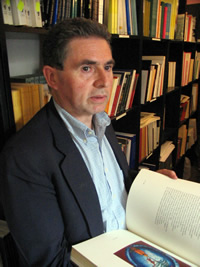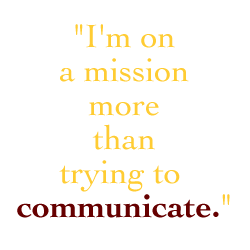 |
Ernesto Paleani wants to document everything. Inside his tiny office on Via Lapis, he can be seen through the window amid his piles of papers and lithograph prints as he diligently and passionately turns ideas into tangible products.
"There are no mistakes," Paleani says about his work. As a book publisher, he gathers much of the necessary information, including the copy and graphics, before he sets the book to print on his digital laser printer. After he makes several copies or "sketches," Paleani personally corrects them. Only when they are to his satisfaction, he continues to print the rest of the copies. |
|
 "Other typographers don't care as much," he says. "There are a lot of mistakes when I leave the work to them." "Other typographers don't care as much," he says. "There are a lot of mistakes when I leave the work to them."
Once his books are printed, he binds each by hand. This tedious process involves gluing pages, then waiting for the glue to dry, gluing more pages, waiting again, and then sewing the pages together to complete the binding. It requires much patience and true passion.
"Business is getting bigger and bigger," Paleani says, peering through his circular-rimmed glasses and claiming that better marketing improves his business every year.
Paleani was not always a Cagliese. Having been born and raised in Rome, he studied law at a university near Vatican City. Although his studies interested him, he loved archaeology. As assistant director to Giulio Andreotti in the national association of the Archeo Club, he wrote a book on Cagli with his sister and other archaeologists. Paleani published enough books on archaeology to begin his own business within three years. |
|
"I'm on a mission more than trying to communicate," he says, explaining that there are 1,700 publishers in Italy, and just 350 of those publishers have ever printed more than 200 books." Paleani is one of these publishers. "We are very few," he says. 
In his opinion, Paleani says, "There are two kinds of publishers in Italy. There are big ones with funds from the government, and there are ones like me who invest their own money and skills personally."
Paleani's inspiration comes from spending days and days looking through books on geography and archaeology in his personal library of 10,000 books, or at the Vatican Library, to which few have access. "A real designer is a person who has this interest and a large archive to look at," he says.
Paleani traces his skills back to 1981 when he first began book publishing by helping a small company in Tivoli named Tipolitografia Paoloni. It was at this company that Paleani developed and evolved his print skills. Twenty years ago, the printing process was performed strictly by Linotype. This involved making and assembling lead letters on a slab, and then pressing the paper over them. |
|
Paleani has had some notable achievements as a publisher. Among them is his most prized book Il Diamante Oggi , or The Diamond of Today . "If I had written it in English, I would have had even more success," he says. In addition, he has many customers who return to him for business. His customers are fairly regular, and most of those who seek his business are looking for "specific studies on specific subjects," he says. "They come because they know what they want." what they want."
Recently, Paleani has been asked by the Israeli government to join several archaeological digs at Mount Sinai. He will document the project, taking place at Harkarcom, and publish 18 volumes of the research. There are 1,300 archaeological sites, dating back from the Paleolithic age, and these digs have been going on for 50 years.
Besides this huge project, Paleani also has several other goals. He wants to specialize in cartography, the practice of making maps. He wants to be able to accurately draw maps of ancient as well as modern cities, and he wants to be recognized as a specialist in this area. |
|
Paleani has also begun to buy books on eBay that discuss the fabled city of Atlantis, varying in all different lengths and languages. He plans on collecting enough books to start his own library dedicated to the subject, buying one book per day. His ultimate goal is to possess every book written on Atlantis in every language and translation. "It's becoming a mania," he says, after comparing it to having a stamp collection.
Although Paleani sees difficult times ahead for his profession, he has no doubt that he will push forward. "There is no normal day," he says, "Every day is different. I may be at a museum, a meeting, sitting in front of the computer, but I never get bored," he continues. "Every day, I meet new people and make new contacts.
"People want to return to the past for pieces of art," he explained. "The Internet is only good for fast information." He believes that what is on the Internet can disappear while writing in print is more valuable. This is why he puts such value on well-designed and published books.
"A book is a piece of art," Paleani says. "It's a creation from scratch." |
|
Photos by Melissa Schantz
Video by Kimberly Schurtz
Web Design by Kevin Zazzali
[HOME] |
|
|
 |
